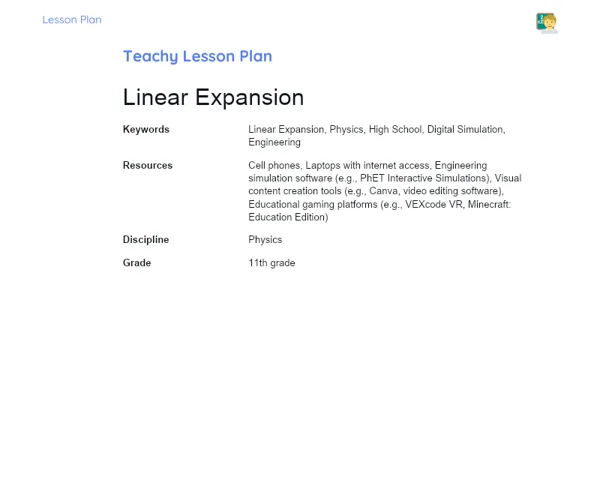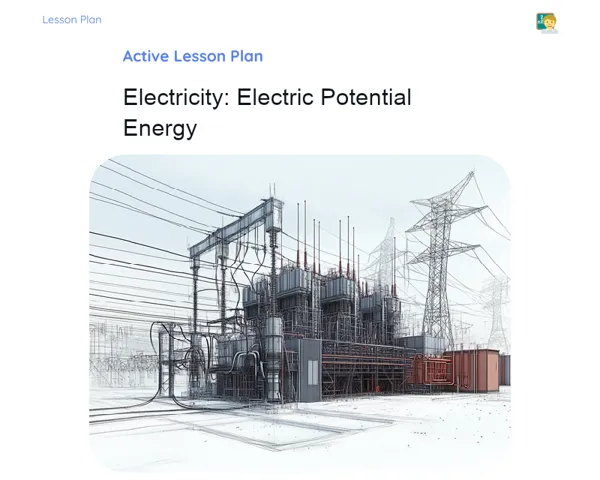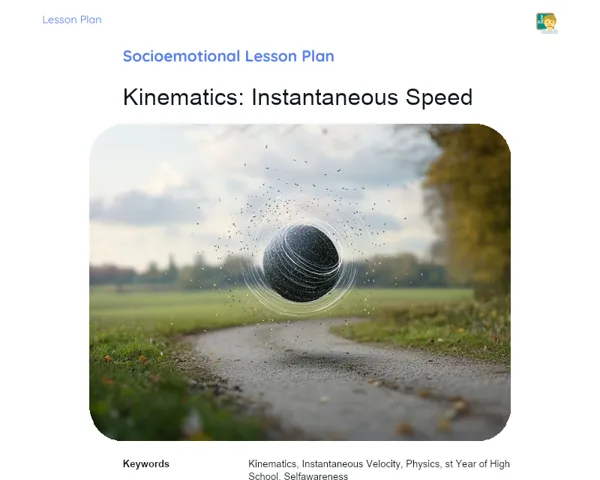Lesson Plan | Lesson Plan Iteratif Teachy | Thermodynamics: Entropy
| Keywords | Entropy, Thermodynamics, Second Law of Thermodynamics, Isothermal Processes, Phase Change, Online Simulations, Meme Science, Gamification, Practical Activities, Social Media, 360° Feedback, Everyday Life, Involvement, Creativity, Digital Learning |
| Resources | Cell phones with internet access, Meme creation apps, Game development platforms (Scratch, Gamefroot), Access to PhET Interactive Simulations, Computers or tablets, Collaborative text editing tools (Google Docs), Projector and screen for presentations, Designated hashtag (#EntropyMemeScience) |
| Codes | - |
| Grade | 11th grade |
| Discipline | Physics |
Goal
Duration: 10 - 15 minutes
The aim of this stage is to clearly outline the objectives the students should meet by the end of the lesson. This creates clarity and sets the stage for both students and the teacher, making sure everyone knows what will be covered and how it’ll be useful in real life.
Goal Utama:
1. Explain the concept of entropy and its implication that the entropy of the universe is always on the rise.
2. Teach students how to calculate changes in entropy during specific processes, like phase changes and isothermal processes.
3. Get students to assess whether there's an increase or decrease in entropy within different systems.
Goal Sekunder:
- Highlight the relationship between entropy and everyday life by connecting it to current events and phenomena.
Introduction
Duration: 15 - 20 minutes
The purpose of this stage is to actively engage students with the topic of entropy, connecting them to practical and relatable examples from their daily lives. By starting off in this manner, students become acquainted with the concept and appreciate its relevance in both modern and usual contexts. This sets the foundation for a deeper conversation and the practical activities that will follow.
Warming Up
Kick off the discussion on entropy by describing it as a measure of disorder or randomness within a system. Stress that, according to the second law of thermodynamics, the entropy of the universe is ever-increasing, meaning that overall disorder tends to grow over time. Ask students to take out their phones and find an interesting snippet related to entropy, like practical examples such as melting ice or the breakdown of organic matter.
Initial Thoughts
1. What is entropy, and how does it relate to disorder in a system?
2. Why does the entropy of the universe keep increasing?
3. Can you provide an example of a process where entropy rises?
4. How do we see entropy in our everyday life?
5. Why is it crucial to get a grasp on entropy when looking at natural and technological processes?
Development
Duration: 80 - 85 minutes
This stage aims to give students a practical and engaging experience while learning entropy concepts. Through varied and creative activities leveraging digital technologies, students can explore and solidify their knowledge dynamically and with contemporary relevance. The teacher acts as a facilitator, guiding collaboration and fostering innovation.
Activity Suggestions
Activity Recommendations
Activity 1 - 🌟 Unpacking Entropy with Meme Science
> Duration: 65 - 70 minutes
- Goal: Leverage humour and creativity to make complex scientific concepts accessible, bolstering student engagement and comprehension.
- Deskripsi Activity: In this fun activity, students will create a series of scientifically-themed memes that clarify entropy concepts. The goal is to merge humour and creativity to explain these concepts and share knowledge across social platforms.
- Instructions:
-
Split the students into groups of up to 5.
-
Instruct each group to select a specific entropy-related concept (e.g., increasing entropy, entropy in phase changes, isothermal processes, etc.).
-
Students need to make 3 different memes that unravel the chosen concept, pairing each meme with a concise textual explanation.
-
Utilise meme-making apps available online or from app stores.
-
Once the memes are ready, students will share them on social media using a designated class hashtag (#EntropyMemeScience).
-
After creating and sharing, each group will present their memes to the class, explaining the concepts behind each.
Activity 2 - 📈 Entropy in Action: Online Experiments
> Duration: 60 - 65 minutes
- Goal: Encourage comprehension of entropy concepts through hands-on virtual experiences, fostering critical analysis and scientific reasoning.
- Deskripsi Activity: Students will engage in online simulations to observe and analyse entropy changes across different processes. Group work will be essential, and students will document their observations in a digital report.
- Instructions:
-
Organise the students into groups of up to 5.
-
Access an interactive simulation website, such as PhET (https://phet.colorado.edu/).
-
Select simulations pertaining to thermodynamics and entropy, like phase changes and isothermal processes.
-
Each group will choose 2 simulations to carry out.
-
During the simulation, students should jot down their observations, particularly noting changes in entropy.
-
Use collaborative editing tools (like Google Docs) to compile a digital report complete with graphs, tables, and their findings.
-
In the end, groups will share their reports with the class and discuss their findings.
Activity 3 - 🎮 Gamifying Entropy: Crafting a Digital Game
> Duration: 70 - 75 minutes
- Goal: Promote programming and creative skills while enhancing comprehension of scientific principles through game development.
- Deskripsi Activity: Students will have the opportunity to create a simple digital game that showcases and explains entropy changes across various processes. The activity will use game development platforms where students can program and test their educational games.
- Instructions:
-
Divide the students into groups of up to 5.
-
Explain that each group must create a game that educates and illustrates concepts of entropy.
-
Use free game-making platforms like Scratch (https://scratch.mit.edu/) or Gamefroot (https://gamefroot.com/).
-
Encourage students to strategize their game, defining which entropy concepts will be covered and how they’ll be expressed.
-
Students will programme the game, testing and refining it as needed.
-
Once completed, each group will share their game with the class, allowing peers to play and give feedback.
-
Each group will present their game and explain the scientific concepts it incorporates and how it assists in understanding entropy.
Feedback
Duration: 20 - 25 minutes
The goal of this stage is to foster both collective and individual introspection on what was learned through the practical activities. Group discussions and 360° feedback provide opportunities to consolidate knowledge, recognise individual and group growth, and create an atmosphere of cooperation and respect. This reflection and sharing of experiences is essential for personal and academic development, promoting deeper, meaningful learning.
Group Discussion
Encourage a group discussion where all students share their learnings from the activities undertaken and their insights. Use the following framework to steer the discussion:
- Request each group provide a summary of the activities they conducted (memes, simulations, games) and the main entropy concepts they explored.
- Ask each group to share the challenges they faced and the lessons they learned during the activities.
- Stimulate a discussion on how the activities enhanced their understanding of entropy changes and its relevance in thermodynamics and daily life.
Reflections
1. How did the activities enrich the understanding of entropy? 2. What challenges did you face during the activities and how did you surmount them? 3. How do entropy concepts emerge in everyday experiences and natural phenomena?
Feedback 360º
Conduct a 360° feedback session where every student receives input from their peers regarding the activity. Guide students to ensure their feedback is constructive, focusing on:
- What strengths did the peer display during the activities?
- In what areas could they improve?
- How did they contribute to the collaboration and success of the group?
Encourage the use of positive language and appreciation of everyone's efforts and contributions within the group.
Conclusion
Duration: 10 - 15 minutes
The purpose of this stage is to solidify learning by reinforcing key concepts and illustrating their relevance in daily life and the contemporary world. This recap and connection phase helps students internalise the content effectively, clarifying how the knowledge gained applies to their lives and academic journeys ahead.
Summary
🎉 Lesson Wrap-Up on Entropy 🎉: Today, we journeyed through the captivating realm of entropy! We imagined the universe as a grand party where disorder is inevitable. We discovered that the entropy of the universe keeps rising (it’s a party that never ends!), calculated its shifts during isothermal processes and phase changes, and explored its varying behaviours in different systems. We made some comical memes, simulated intricate processes, and even developed games to articulate these concepts! 🚀
World
🌍 In Today’s World 🌍: The lesson highlighted how entropy is present in all aspects of our lives. From melting ice to the ageing of celestial bodies, entropy acts as a constant force. We combined social media, online simulations, and game creation to bridge these concepts to our digital lives today. This brought to light the intertwined nature of science and technology, playing a pivotal role in the world we inhabit.
Applications
🔎 Real-World Applications 🔎: Grasping entropy is vital for a multitude of domains, from engineering to biology. It aids in forecasting how systems will evolve and understanding the limitations of energy efficiency. In everyday life, comprehending entropy can help us acknowledge the irreversibility of various processes, like how things deteriorate or the necessity of recycling materials.



